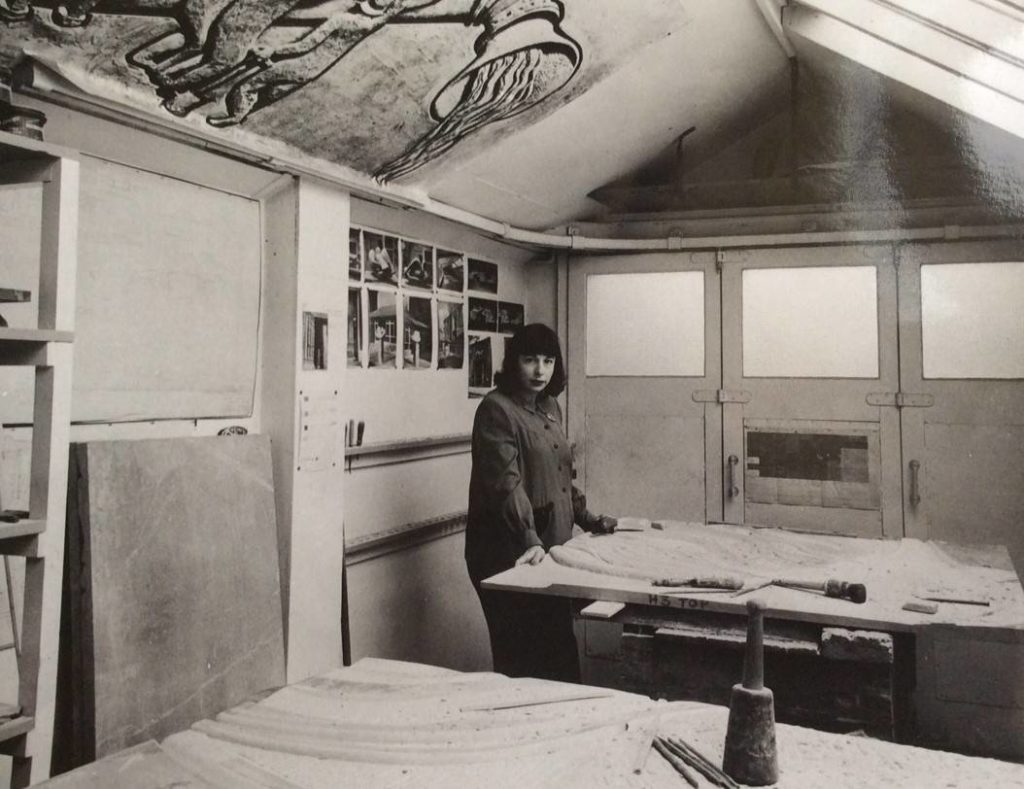Blog: Antonia Cunliffe Davis
The daughter of Manchester sculptor Mitzi Cunliffe, who designed the BAFTA trophy, on celebrating her life and work
At various stages over the past 30 or so years I have made pilgrimages to my childhood home, at first with my father and stepmother, then with my sister and our partners and more recently with my now grown-up sons. We did little more than stand on the pavement looking at the house. Now I am very pleased to be returning again to Manchester where I was born and grew up until my teens to join the celebrations surrounding my mother Mitzi Cunliffe. She produced a fantastic body of work from a humble garage studio in the 1950s at our suburban house in a Didsbury cul de sac.
My mother called herself a “sculptor for architecture”, preferring this description to the term “sculptress”, which was then in current usage. In a busy and productive few years she generated many significant projects from her Didsbury studio. Now thanks to the vision, enthusiasm and determination of the Twentieth Century Society North West and the Manchester Modernist Society, we shall be unveiling a plaque on the house to celebrate her artistic achievements.

Her move from New York to Manchester upon marriage to my father Marcus Cunliffe, the English historian and academic who taught at the University of Manchester, led to a series of sculptural commissions in England. The first significant one was her participation in the Festival of Britain, which took place on the South Bank near Waterloo Station in the summer of 1951. For this she designed an eight and a half foot entwined couple called Root Bodied Forth as well as door handles and a light fitting. The whereabouts of this sculpture in concrete remains unknown. I like to think it ended up in someone’s garden or house at the close of the festival rather than in a skip.
Her participation in the festival helped her to secure subsequent commissions. These include the hand-carved Man-made Fibres sculpture at the University of Leeds. Thanks to the dynamism of Professor Ann Sumner the sculpture was cleaned and celebrated there two years ago.
1955 was an important year in terms of creative and family life. A son Jason was added to the family that spring, and Mitzi designed and handmade the Haweswater Aquaduct bas-relief sculpture at Heaton Park in Bury, Greater Manchester, which is now listed. I knew this splendid green stone sculpture only from black and white photographs of the period. We made a pilgrimage to see it in chilly March and it is more beautiful and impressive than I had imagined. She also made a three part carving, Threshold which is still in place over the front door at Manchester High School for Girls, as well as a sculpture, Man and Technic, at the Manchester Health Academy.
Her best known work was also designed that year, the BAFTA award trophy. Despite BAFTA’s mask trophy being integral to the organisation as its logo and playing a central part of the stage design of the broadcast ceremonies, my mother’s role is less well known.
I have been asked before what I recall of my mother working on all of these projects and the true answer is very little – due to how young my sister and I were at the time. We went to primary school and outside school played with our dolls, our cats and did colouring, drawing and sewing. Uncovering staged photos from the family albums shows us doing these activities. I also recall being encouraged to make things and had easels and paints and crayons and felt and needles and wool to encourage for my own artistic expressions.
When she looked back over her artistic career she always said that coming to live in Manchester in 1949 had enabled her to make more of a mark as an artist than she would have had were she to have remained in the competitive artistic environment of New York. She was always a representational artist at a time when art was moving towards abstract expressionism and colour field painting. In the early 1960s she moved into the production of Sculpture by the Yard. This was the name she gave to mass-produced sculpture on buildings cast in modular form from concrete and fibreglass. Manchester has an example of this at the student hall of residence called Cosmos 1. Again, when I finally saw this in person I was struck by how much more impressive it looks than I expected, knowing it only from black and white photographs of the period.
We are planning to create a sculpture trail to allow more visitors to come to see this work and learn more about Mitzi, and to be able to find and visit other sculptures in Manchester and in Liverpool.
Professor Ann Sumner and Antonia Cunliffe Davis host Mitzi Cunliffe: An American in Manchester. For more details or to book for the talk at the Whitworth on 30 June visit modernist-society.org/events/2018/6/30/mitzi-cunliffe-talk
